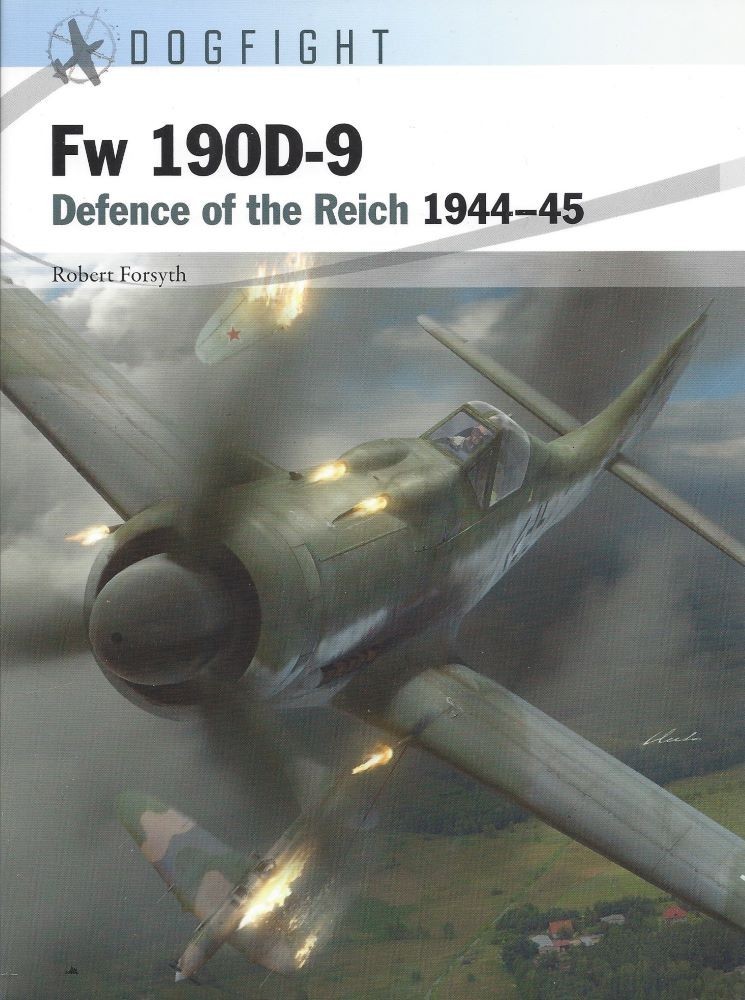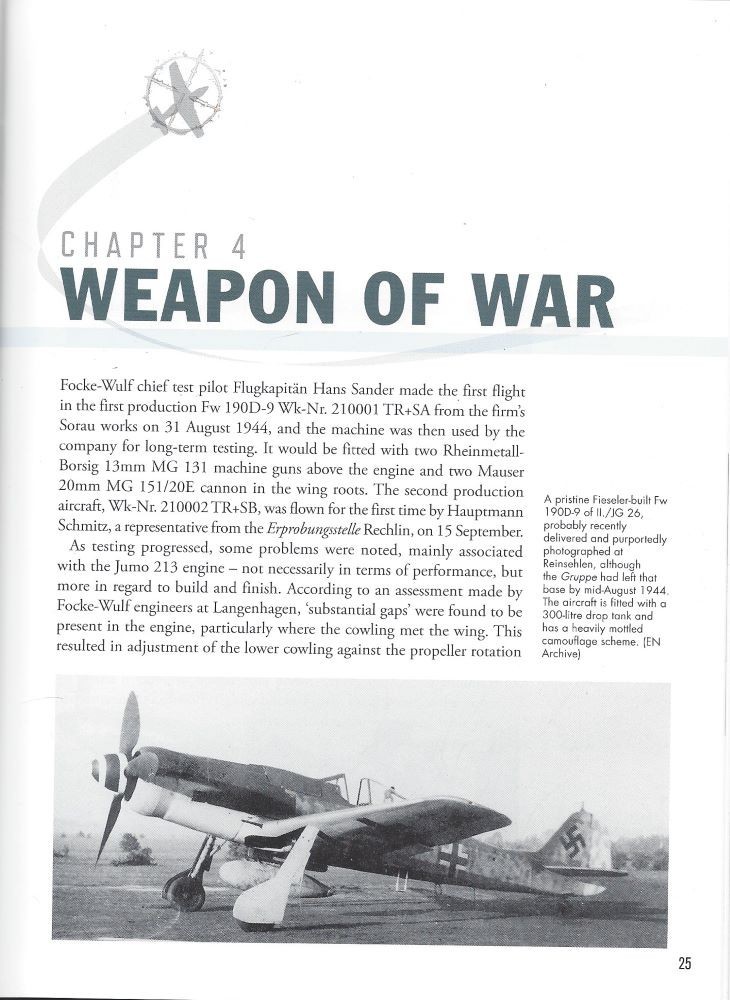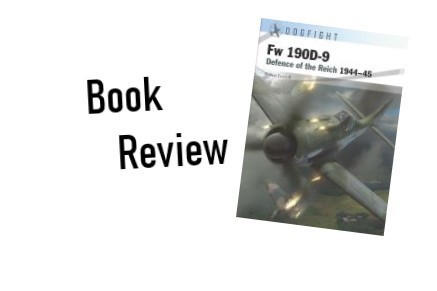Introduction
The premier of Osprey’s newest series, Dogfight 1, Fw 190D-9, Defence of the Reich 1944–45, is authored by Robert Forsyth and illustrated by Gareth Hector, Tim Brown and Jim Laurier. Catalogued as ISBN 9781472849397 and Osprey’s short code DOG 1, it is 80 pages of content and available in softcover, PDF and ePUB – each with a different ISBN.
Osprey introduces this book as;
The Fw 190D-9 - the ‘long-nosed' Dora - represented the cutting edge and pinnacle of wartime Germany's piston-engine aviation development. This new history by leading German aviation specialist Robert Forsyth reveals what it was like to pilot her in combat as Germany desperately battled to remain in the war.
Arguably one of the finest piston-engined fighters ever built, the Focke-Wulf Fw 190D-9 raised the bar in terms of aircraft design and operational capability during World War II. Designed by Kurt Tank, the ‘long-nosed' Fw 190D9 ‘Dora' bettered most of the fighters that the Allied and Soviet air forces could field when it first appeared in the skies over the Western and Eastern Fronts in1944. Indeed, with experienced German pilots at the controls it proved to be an immediate match for even the later-mark Griffon Spitfire and the P-51D/K. Well-armed,with two 13mm machine guns and two 20mm cannon, the D-9 began to equip Luftwaffe units from August 1944. Later on in the war, one of the key missions of the D-9 was to provide top cover for Me 262 jet fighters when they were at their most vulnerable during take-off and landing.
Featuring first-hand accounts, photographs, artwork and innovative and colourful 3D ribbon diagrams, this fascinating volume portrays what it was like to fly the superlative Fw 190D-9 in combat, providing a realistic insight in to how German pilots used the superb Focke-Wulf aircraft in combat against American, British and Russian fighters in the Defence of the Reich in 1944-45.
Preflight complete - let's climb in.

Content
Fw190D-9 Defence of the Reich 1944–45 is brought to us through 10 chapters and sections in 80 pages:
Introduction
Chapter 1
In Battle
An all-action account of III.JG 54 engaging Typhoons or Tempests over western Germany in April 1945
Chapter 2
Setting the Scene
Design, development, production, early actions, the Ardennes and Operation Bodenplatte
Chapter 3
Path to Combat
Charting the careers of two Luftwaffe pilots who flew the D-9 in combat - one, a Knight's Cross-holder and ace, the other, a lesser known ‘Dora 9' pilot
Chapter 4
Weapon of war
A brief technical appraisal of the Fw 190D-9, detailing its development and the weaponry it employed
Chapter 5
Art of War
Tactics for Fw 190D-9 units were quite ‘loose', as was tactical doctrine by this stage of the war - the key word was ‘survival'. This chapter will look at the ‘Split S' manoeuvre and the evolution of the Rotte and Schwarm tactical formations
Chapter 6
Combat
In this chapter, Fw 190D-9 pilots explain what it was like fly the ‘Dora 9' in an aerial engagement against some of the best Allied fighters of World War II such as the Spitfire XIV, P-51D Mustang and Tempest V
Aftermath
Selected Sources
Index
First hand quotes
Multiple first-hand accounts by German pilots provide personal insights of flying and fighting the Dora; Allied pilot records of fighting them are also included, in dogfights with Spitfires, Tempests, Typhoons, and Mustangs. Never try to out-turn a Mustang, I tried! lamented one Dora ace. Some of the pilots are well-known including Oskar Romm, who recalled:
- All of our Dora-9s were fitted with a Jumo 213A engine which, with water methanol injection, develop 2,240 horsepower. As an air superiority fighter, the Dora handle better than the FW 190A; it was faster and had a superior rate of climb. During dogfights at altitudes between 3,050M and 7,300M, usually when engaging the Russians, I found that I could pull the Fw 190D into a tight turn and still retain my speed advantage. In the FW 190A I had flown previously, during dogfights I often had often to reduce to minimum flying speed in the turn. In the descent the Dora-9 picked up speed much more rapidly than the A-type: in the dive it could leave the Russian Yak-3 and Yak-9 fighters standing.
Pilot reports are included of developing, testing and evaluation of Focke-Wulf. One pilot described check-out familiarization with the Dora and severe problem that cropped up in tight turns. He also describes the solution to it, and also noted that it was unknown if Junkers submitted a modification report to the BAL (construction supervisory board). Yet another German pilot described the Dora as a ‘splendid machine;’ he stated that once the problems were cleared up, there were scarcely any complaints.
Of pilot descriptions, not everybody had the same assessment of their Dora. Oberleutnant Hans Hartigs said, “The Fw 190D-9 “Long Nose” I did not enjoy flying: I found earlier types much better in dogfights and turning ability. The engine in the D-model in fact ran more roughly and it was very insensitive when shooting." Yet another assessment of the Dora's quality came from American test pilots who flew it after the war, and another German Experten who described the Dora as a, “Splendid machine.”
If you are a technical geek like me, you'll enjoy the descriptions of the abbreviations and acronyms of German aircraft equipment, i.e., the armament switch and control panel, homing equipment. Among other systems this book provides a good description of the oil system: reservoir and delivery to the engine, thence the radiators, and how it returned to the oil tank. Not all Doras looked the same: Chapter 4 Weapon of War presents interesting information about variations in the upper cowling over the fuselage machine guns because different factories had their own designs. We also learn of attempts to increase the power of the engine with, and without, the menthol water boost system, as well as some other tricks to increase the horsepower. The book also discusses which companies and factories produced components for the aircraft, i.e., who built the wings or undercarriage doors, fuselage and wing sections, where landed gear components and canopies were made, that ailerons and flaps were made by Focke-Wulf at one of their plants.
Have you wondered what a day in the life of a Jagdflieger was like? The first six pages of Chapter 5 Art of War are fascinating beyond the mere combat performance of the Dora. The narratve starts out describing the life and routine of a German fighter pilot from awakening in their billets, transportation, breakfast, the type of buildings they lived in or operated from, preflight briefing, routines while waiting for a mission, tactical briefings, camouflage and dispersement, duty of the mechanics and armorers, entering the aircraft in preparation of flight, and how to get from the dispersal area to the runway along narrow rutted taxiways in spite of that huge honking visibility killing engine out front. Interesting anecdotes not usually included in such publications, such as Unteroffizier Werner Molge of 7./JG 26 recalling formation takeoffs and the effect of proceeding aircraft wake turbulence.
Continuing with detailed descriptions of aircraft formations and communication follow as well as exploring some personal methods of airborne leadership.
- In order that my pilots always know where their boss is, I ordered that my aircraft tail is painted bright yellow. This is very colorful and we can be seen for a great distance. I don't care if the Americans and British will take mine to be the leaders aircraft: I have my pride too. With my little yellow tail everything works out fine. I don't have to scream my head off when the novices fly after the wrong aircraft during a diving attack, and they save themselves a dressing down after they land.
Part of the Dogfight series are descriptions with illustrations of specific dogfights. One is Dora's engaging Tempest Vs over the Munster area. It includes a disturbing antidote of a German pilot in his parachute being rammed by a pilotless British fighter as it spun down in flames, setting the German’s parachute afire. The dogfight is illustrated on two pages with tactical ribbon diagrams, described with a callout box narrating seven significant phases of the battle. The other illustrated dogfights show encounters with the Spitfire XIV, P-51D, and Tempest V.
Aftermath offers a brief account of other Dora variants and developments, and the Long Nose's impact on the last nine months of the air war.
Photographs, Artwork and Graphics
A relevant gallery of photographs support the text. I did not count them and estimate at least one photo on 2/3s of the pages. There are a few I do not recall seeing before, including a Dora emblazoned with the caption, “In he goes even if we both cry.” One pilot portrait is in original color. Modelers will find many images to inspire a model or diorama, and one can find many good views of aircraft parts, and camouflage and markings.
What the camera missed is recreated by artists Hector and Laurier; dogfight ribbon diagrams are by Tim Brown. Their artwork supports the photos as much as the photos enhance the text. Each dogfight scene consists of two-page spreads illustrated with the aircraft, and their movements via ribbon diagrams.
Dogfight reconstruction with tactical ribbon diagrams, 1 May 1945: Doras bounced by Spitfire XIVs, keyed to six phases with descriptive captions.
Dogfight reconstruction with tactical ribbon diagrams, 24 March 1945: Doras attack P-51Ds, keyed to six phases with descriptive captions.
Two-page battle scene Spitfire Down: a Fw 190D-9 pulling away from a vanished Spitfire IX.
Dogfight reconstruction with tactical ribbon diagrams, 27 December 1944: Doras verses Tempests in a complex fight, keyed to seven phases with descriptive captions.
‘Finger-four’Formation: Schwarm formation depicting the formation of the aircraft from overhead.
Fw 190D-9 Armament, including a cutaway of the weapons, with descriptions.
Artwork: a graphic reproduction from a Focke-Wulf Fw 190D-9 handbook illustrating the aircraft armament comprising the machine guns, wing mounted cannon, the gun sight and ammunition containers, keyed to 24 components.
Map Main Luftwaffe Fw 190D-9 bases in the West 1944-45: nine Gruppen associated with dozens of bases.
Those graphic components of the book provide enjoyable and informative visual content that is well worth the space.



Conclusion
Osprey's new Dogfight Series is off to a good start with Fw 190D-9 Defence of the Reich 1944–45. It presents a scholarly material full of first-hand Dora pilot reports and reminiscences focused on "There I was" accounts as well as technical details. Modelers, historians and enthusiasts of the Focke-Wulf 190D-9 should find this book to be a concise, useful and unique part of the aircraft's history. Modelers may find source material and inspiration for their Fw 190D model. A useful gallery of photographs and artwork provide support to the text.
I thoroughly enjoyed learning about the Fw 190D as presented in this title and I look forward to the next subjects in the series. Recommended.




























